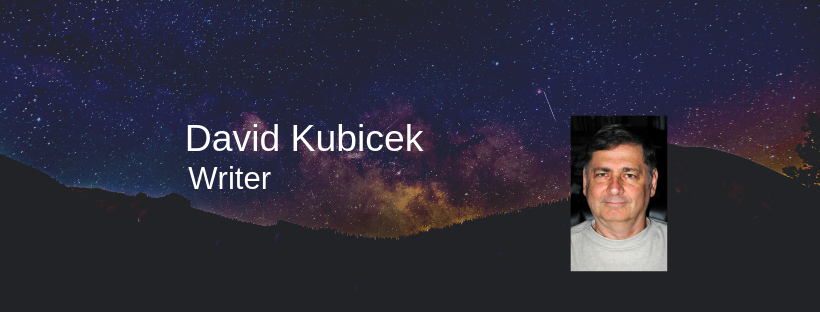by David Kubicek
 Stories from the Heartland, the fifth volume of the Nebraska Writers Guild’s (NWG) annual Voices from the Plains series, was released the first week in December. The anthology contains short stories, poetry, flash fiction, nonfiction, novel excerpts, and memoirs written by NWG members.
Stories from the Heartland, the fifth volume of the Nebraska Writers Guild’s (NWG) annual Voices from the Plains series, was released the first week in December. The anthology contains short stories, poetry, flash fiction, nonfiction, novel excerpts, and memoirs written by NWG members.
My story “A Place of Their Own” is included in the short story section. I wrote this story for a writing workshop at the University of Nebraska-Lincoln (UNL) in the summer of 1976. The story is set in my first apartment. I polished the prose because I am, I hope, a much better writer now than I was 45 years ago. I also updated it, giving my characters cell phones and increasing the rent slightly. For instance, in the story Chris and Jennifer pay $100 a month for the apartment; when I lived there, I paid $67.40. Why it was $67.40 is something known only to my landlord and God. Why not $65 or $70, or even $67 or $68. What was the 40 cents for?
The Kindle eBook of Stories from the Heartland is $3.99 and the paperback is $18.99. It can be purchased from Amazon and Barnes & Noble and may be available from other online dealers.
 About a week after Stories from the Heartland came out, the NWG released Flashes on the Plains, the organization’s first flash fiction anthology. For this collection, flash fiction–what we called short short stories in the olden days–are stories of 1,000 words or fewer. There are 18 stories in this book, which makes it no more than 18,000 words of fiction, which makes it a slim volume–67 print pages counting Margaret Lukas’s introduction but not counting the index of stories and authors.
About a week after Stories from the Heartland came out, the NWG released Flashes on the Plains, the organization’s first flash fiction anthology. For this collection, flash fiction–what we called short short stories in the olden days–are stories of 1,000 words or fewer. There are 18 stories in this book, which makes it no more than 18,000 words of fiction, which makes it a slim volume–67 print pages counting Margaret Lukas’s introduction but not counting the index of stories and authors.
I have two stories–“An Evening Stroll” and “Spare Parts”–in this anthology, and I wrote both of them in the spring of 2021. I called on my subconscious to write “An Evening Stroll”; by thinking about it intensely before I went to sleep at night, my subconscious turned it over while I slept, and when I woke up I had the story. Your subconscious can be a great tool if you put it to work.
The eBook of Flashes from the Plains is $1.99 and the paperback is $8.99, and it can be purchased from Amazon .
The NWG is one of the oldest continuous writers organizations in the United States. It was founded in 1925 and counts Mari Sandoz, Bess Streeter Aldrich, John G. Neihardt, and Willa Cather among its first members.
For more information about David Kubicek’s books click here.

 Whiskers was a blue-eyed gray and white kitten who was given to us by someone who found him abandoned in an alley when he was five months old. We had a black Lab named Kabella, and we were told to separate the two of them for a while so they would get used to each other’s scents.
Whiskers was a blue-eyed gray and white kitten who was given to us by someone who found him abandoned in an alley when he was five months old. We had a black Lab named Kabella, and we were told to separate the two of them for a while so they would get used to each other’s scents. Kabella wasn’t hurt because Whiskers had no claws on his front feet. But Whiskers had delivered his message. He’d told the dog, in no uncertain terms, to chill out.
Kabella wasn’t hurt because Whiskers had no claws on his front feet. But Whiskers had delivered his message. He’d told the dog, in no uncertain terms, to chill out. In the living room there was a ledge at the top of the stairs that led down to the basement. Whiskers liked to sleep on that ledge. One time in his sleep he rolled over and plummeted 15 feet to the basement floor. We rushed to the ledge in alarm and peered over the ledge. Whiskers was standing, looking around sheepishly. The only thing injured was his pride. Apparently, there is some truth to the old saying that cats always land on their feet.
In the living room there was a ledge at the top of the stairs that led down to the basement. Whiskers liked to sleep on that ledge. One time in his sleep he rolled over and plummeted 15 feet to the basement floor. We rushed to the ledge in alarm and peered over the ledge. Whiskers was standing, looking around sheepishly. The only thing injured was his pride. Apparently, there is some truth to the old saying that cats always land on their feet. I was in elementary school when I first read about how the
I was in elementary school when I first read about how the 

 reception, I think we succeeded, or at least we collected a group of horror stories as good as anything on the market.
reception, I think we succeeded, or at least we collected a group of horror stories as good as anything on the market.
